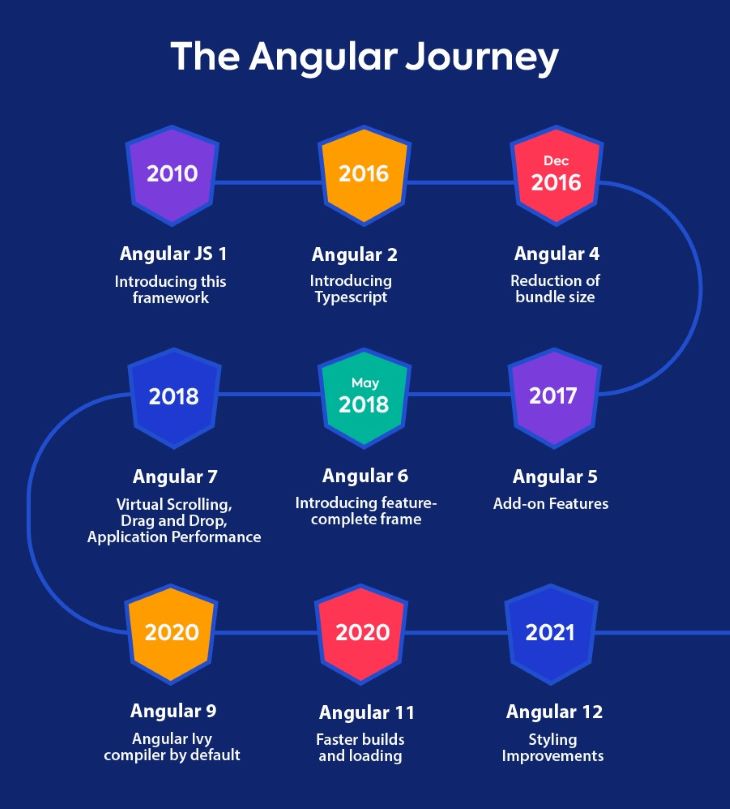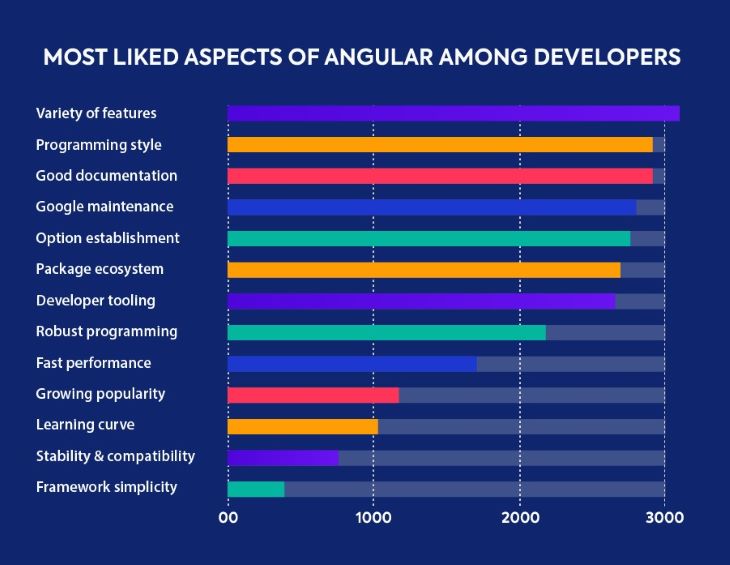The term Angular or Javascript is no longer alienated across the globe. Even the non-techies are found understanding the true significance of such popular and feature-rich web development frameworks. Well, it’s been quite a while since Angular was introduced in the web development realm and since then we saw Angular 1, Angular 2.0, Angular 4.0, Angular 5.0, Angular 6.0, Angular 7.0, Angular 8.0, Angular 9.0, Angular 10.0, Angular 11.0, Angular 12, Angular 13, Angular 14 and now we have much anticipated Angular 15.
Yes, we have Angular 15! The following post simply tends to unveil the major revamps featured in the latest version of Angular. That being said, here I would like to shed some light on Angular 15 release and why it should be in your full-potential list. But before that let’s take a bit of a detour and understand what exactly Angular is all about.
Angular is one of the leading open-source Javascript frameworks written in Typescript which eventually leads to increase in productivity and efficiency of a web developer. One of the best aspects of Angular is that this particular framework is backed or should I say maintained by Google. So there is nothing much to worry. On top of that, Angular was established with a sole purpose of developing single-page applications, enterprise web apps, mobile apps, animated UI, progressive web apps, and so forth.
Now why this framework? Well, there was a time when developers used to keep rewriting the code again and again right from the scratch. As a result, lots and lots of time and energy were consumed. Since the inception of frameworks, more and more time can be saved. This surely enables developer to skip the monotonous and tedious tasks and come up with some innovative solutions for their end users.

Being a popular and renowned contributions to the web development realm, Angular seems to have come a long way and still there is a long way to go. Some of the core reasons behind its popularity can be due to its open-source nature and the massive and active community of programmers, individuals, veterans working day in day out to. Apart from all this, it is highly backed by Google and that’s why it is loved by millions of developers for conducting mobile or desktop web applications projects for their clients. Besides, this TypeScript-based front-end development framework comes with some unique Angular features and functionalities with it’s each and every version, and Angular 15 won’t be an exception here!

The above image offers some highly rated factors or should I say aspects that are loved by web developers all across the globe. Further let me show you some crucial reasons to use Angular for your upcoming web development project.
#1 Highly supported by Google
One of the biggest benefit or advantages to take into account here is that Angular is thoroughly backed by Google since its inception. The tech giant has been offering seamless amount of support since the beginning and it will keep on offering the same for a very-long time. In fact, the tech giant company have themself used Angular in the making of some of the most popular Angular apps. And trust me, nothing beats the Javascript framework when it comes to stability.
#2 Consistency
Another solid reason to choose Angular is that it offers great amount of consistency. Whether your project is small or large, whether you are developing single-page applications or enterprise-based apps, the Javascript framework ensures seamless consistency, all thanks to its CLI tools. Here developers can use repetitive blocks of code from the command line.
#3 Cost-effectiveness
For starters you might not agree with me that Angular isn’t costly but if you see the big picture, you will find that overall conducting Angular development project from a reputable company can be pretty time and money saving. Simply ask your developers to come up with a high quality website and they exactly know what features and functionalities to consider. In tandem to web development, testing in Angular is pretty simple. So the chances of finding bugs and errors in the later phase or post release phase are pretty low.
#4 Great in-Performance
Some of the most intimidating features of Angular such as template syntax, Angular CLI, Routers, Declarative UI, Simplified MVC pattern, etc ensures to support developer’s work and results in quick development. And this is because Angular comes with loads and loads of ability to interact well with a wide range of backend programming languages.
#5 Security
Last but certainly not the least concern for every web development project is that will it have immense amount of security measures. And this is when you have to choose a framework that already excels when it comes to security. Angular works excels in the subject of data security. Check out the general data protection regulation offered by Angular.
So enough being said about why one must consider Angular as it’s ultimate web development framework. Time to focus on Angular 15 and what’s all in its bag.
Angular 15 is here!
With the dawn of 2023, we have seen several releases among the web development realm such as Node.js 19, Vite 3.0, TezJS, React 18 , Angular 15 and a lot more! The latest Angular version was developed by whom, any guesses? Of course, Google itself! Last year 2022, on the 18th of November, the Typescript-based framework released its latest and the most alluring version. Now why alluring, will discuss it in a while!
After the grand success of Angular 14, the stakes got really high when it came to Angular 15. As a result, in the November, 2022 the latest version or should I say the much-awaited version was launched. And here you will find dozens of refinements leads leading to enhanced performance and enhancing the overall developer’s experience.
Certain features offered by Angular 15 include Stable Standalone APIs, HTTP with provideHttpClient, Forms, Enhanced stack traces especially for debugging, Router Unwraps Default Imports, Dependency Injection, Deprecation, CDX Listbox, Angular CLI improvements, ESbuild Support, stable image directives, Automatic imports in language services and a lot more!
Technology keeps on evolving and it’s true for each and every sector within including Angular development. In the span of every six months, Angular comes with a new release and that too an interesting one. Further, its time to unveil some core features of Angular in detail. So let’s begin!
Features of Angular 15
Stable Standalone APIs
There was a time when standalone components in Angular framework weren’t much stable. Well, fortunately, that’s not the case anymore! In fact, the feature is totally out of the developer review mode. In today’s times, Angular developer can create an application and that too a successful one without using any module. Stable Standalone APIs work as a blessing for newbies or junior Angular developers. You see now their learning process is quite simplified as well as their entire development experience is streamlined.
According to the official document, here it is how to use standalone.
import {bootstrapApplication} from '@angular/platform-browser';
import {ImageGridComponent} from'./image-grid';
@Component({
standalone: true,
selector: 'photo-gallery',
imports: [ImageGridComponent],
template: `
… <image-grid [images]="imageList"></image-grid>
`,
})
export class PhotoGalleryComponent {
// component logic
}
bootstrapApplication(PhotoGalleryComponent);
These standalone components are fully functional and now there is no need for using HttpClientModule as you have provideHttpClient.
Multi-Route Application Development
Another interesting feature to take into account is multi-route application. Here you will find a router standalone API to develop multi-route applications.
export const appRoutes: Routes = [{
path: 'lazy',
loadChildren: () => import('./lazy/lazy.routes')
.then(routes => routes.lazyRoutes)
}];
And the lazy routes are declared in this manner
import {Routes} from '@angular/router';
import {LazyComponent} from './lazy.component';
export const lazyRoutes: Routes = [{path: '', component: LazyComponent}];
Another interesting aspect here to take into account is that all the unused features can be successfully removed by the Angular bundler.
Directive Composition API
The next interesting feature to focus on in angular 15 is Directive composition API. It may quite interest you to know that it was Github who compelled the developers to incorporate such a feature in Angular 15. Now what exactly Directive composition API do? Well, it enables or assists well in code reusability. Here developers tend to build applications using the code reusability feature and this surely results in effective time management. Another interesting aspect that must be taken note of is that under this component, all the directives are declared; thus, the Directive Composition API feature is implemented. Here’s how you can apply directives to a host element.
@Component({
selector: 'mat-menu',
hostDirectives: [HasColor, {
directive: CdkMenu,
inputs: ['cdkMenuDisabled: disabled'],
outputs: ['cdkMenuClosed: closed']
}]
})
class MatMenu {}Improvised Stack Traces
The next interesting feature to take into consideration is improved stack traces. With the release of Angular 15, the debugging of angular applications using stack traces has become pretty easy and a doable job. On the contrary, the entire debugging process has become more easy and straightforward. Here programmers can trace more and more of the development code. Now, Angular developers received one-liner error messages especially at the time of any bug-discovery whereas earlier it was quite a lengthy procedure.
This is a sample stack trace in an Angular app.
ERROR Error: Uncaught (in promise): Error
Error
at app.component.ts:18:11
at Generator.next (<anonymous>)
at asyncGeneratorStep (asyncToGenerator.js:3:1)
at _next (asyncToGenerator.js:25:1)
at _ZoneDelegate.invoke (zone.js:372:26)
at Object.onInvoke (core.mjs:26378:33)
at _ZoneDelegate.invoke (zone.js:371:52)
at Zone.run (zone.js:134:43)
at zone.js:1275:36
at _ZoneDelegate.invokeTask (zone.js:406:31)
at resolvePromise (zone.js:1211:31)
at zone.js:1118:17
at zone.js:1134:33With combining with ChromeDevtools, things became more easy to do. Here’s the example:
ERROR Error: Uncaught (in promise): Error
Error
at app.component.ts:18:11
at fetch (async)
at (anonymous) (app.component.ts:4)
at request (app.component.ts:4)
at (anonymous) (app.component.ts:17)
at submit (app.component.ts:15)
at AppComponent_click_3_listener (app.component.html:4)Final Words
I can simply go on and on with the features offered by Angular 15 but the aforementioned are the main ones to take into account. So basically lots and lots of improvements are found and will be found in the upcoming versions. So I hope you enjoyed reading the post. Now if there is some feature that you want us to add then feel free to mention in the comment section below.
